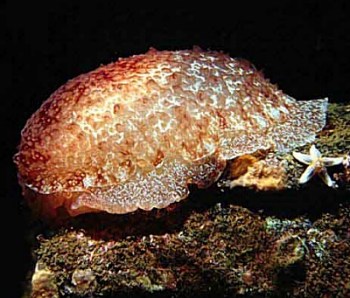

Pleurobranchus membranaceus
(Montagu, 1815)
Order: NOTASPIDEA
Superfamily: PLEUROBRANCHOIDEA
Family: Pleurobranchidae
DISTRIBUTION
Western Mediterranean, Atlantic coast of France, British Isles.
PHOTO
West coast of Scotland. Lower photo showing typical swimming behaviour (See message below) June 1996 at Loch Fyne on the west coast. An individual 70 mm long, swimming in open water at 15 metres. Photos: Jim Anderson.
Feeds on simple and compound ascidians. Grows to 12cm in length.
P. membranaceus swims upside down with an asynchronous flapping of the foot. The mantle hangs down and is not used in swimming, while the sides of the foot extend out as large thin flaps, much larger than when the animal is crawling. During swimming the foot on one side performs a swimming stroke by sending a wave from the front to rear and then while it is recovering for the next propulsive stroke, the other side of the foot undergoes its propulsive stroke. This makes swimming a very ungainly unstable movement, the animal rolling from side to side as it swims along. Animals do not appear to swim in any direction.
Reference:
• Thompson, T.E. & Slinn, D.J. (1959) On the biology of the opisthobranch Pleurobranchus membranaceus. Journal of the Marine Biological Association, United Kingdom, 38: 507-524.
Rudman, W.B., 2001 (April 19) Pleurobranchus membranaceus (Montagu, 1815). [In] Sea Slug Forum. Australian Museum, Sydney. Available from http://www.seaslugforum.net/find/pleumemb
Related messages
Pleurobranchus membranaceus from Little Loch Broom, Scotland
February 7, 2007
From: Karen Williams
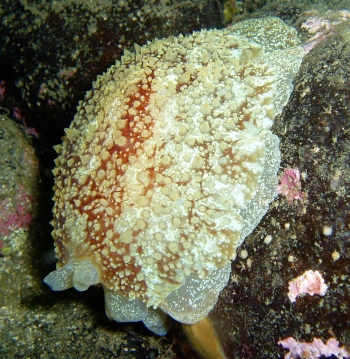
Dear Bill
I have recently discovered the Sea slug Forum and am impressed with the amount of information it provides.
Could anyone help me indentify this nudibranch from Scotland. I orginally thought it was Archidoris pseudoargus, but because of the red brown blotches now think it might be Discodoris plana.
Locality: Conger Stack, Little Loch Broom, Camusnagaul, Dundonnell, 30 metres, Wester Ross, Scotland, UK, North Atlantic Ocean, 09 August 2005, Rocky pinnacle in sea loch. Length: 70 mm. Photographer: Karen Williams.
Thanks.
Karen Williams
karenalwilliams@btinternet.com
Williams, K.A.L., 2007 (Feb 7) Pleurobranchus membranaceus from Little Loch Broom, Scotland. [Message in] Sea Slug Forum. Australian Museum, Sydney. Available from http://www.seaslugforum.net/find/19294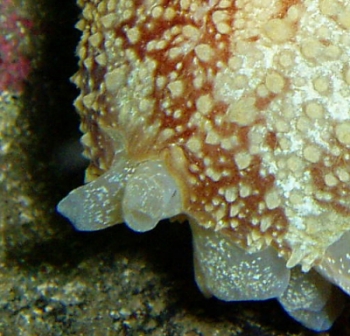
Dear Karen,
In the close-up alongside yopu will see that this animal has a pair of tube-like rolled tentacles quite unlike the rhinophores of dorid nudibranchs like Archidoris and Discodoris. Your animal is the 'side-gilled slug' Pleurobranchus membranaceus. As you will see from the attached messages, this species can sometimes be found in large numbers in Scottish waters.
Best wishes,
Bill Rudman
Pleurobranchus membranaceus egg-laying frenzy
June 15, 2006
From: Jim Anderson
Dear Bill,
Apart from seeing polycerids recently [see message #16874], we are experiencing a Pleurobranchus membranaceus egg laying frenzy at a sea loch site on the west coast of Scotland I dived on Sunday last - dozens of large egg masses and animals still spawning, mating, feeding and just hanging about - all in 6-10 m over the sandy, stony bottom. They have been around since Feb with the first spawn masses in April.
Regards,
Jim A
jander4454@gmail.com
Anderson, J., 2006 (Jun 15) Pleurobranchus membranaceus egg-laying frenzy. [Message in] Sea Slug Forum. Australian Museum, Sydney. Available from http://www.seaslugforum.net/find/16875Dear Jim,
Thanks for this information. From your earlier message [#7001] in May 2002, it would seem this breeding 'frenzy' is a regular occurrence in your Spring. We have quite a few examples of Sea Hares with such 'mass events' [see Population Fluctuations] but there are examples to be found throughout the sea slugs, but they are just not usually as noticeable.
Best wishes,
Bill Rudman
Re: Pleurobranchus membranaceus feeding
July 12, 2004
From: Robert Smith
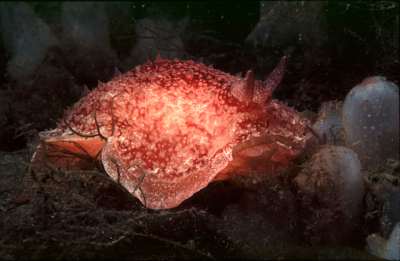
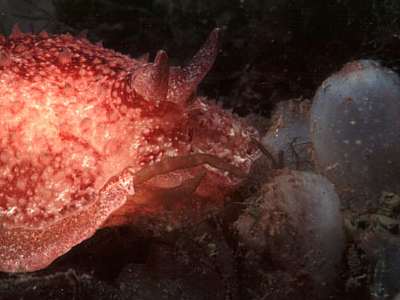
In reference to earlier messages on Pleurobranchus membranaceus feeding [m11604], here is another image of this species from the cliff face south of Kenmore Point in Loch Fyne, Scotland. The image was taken on 22 June 1991, and in my logbook I noted that there were multiple specimens around the 6 - 7 metre mark with egg cases evident.
Robert Smith
scotdiver@hotmail.com
Smith, R., 2004 (Jul 12) Re: Pleurobranchus membranaceus feeding. [Message in] Sea Slug Forum. Australian Museum, Sydney. Available from http://www.seaslugforum.net/find/12589Thanks Robert,
It certainly seems to be taking an interest in these solitary ascidians
Best wishes
Bill Rudman
Re: Pleurobranchus membranaceus feeding
December 6, 2003
From: Jim Anderson
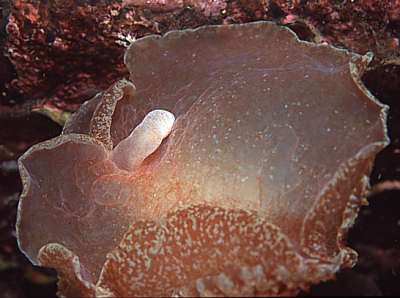
Dear Dr. Rudman,
The attached photo of Pleurobranchus membranaceus was taken with my film camera during my November dive that I previously sent you images frm the digital camera. This is one of the 50mm specimens detached from the ascidian and turned over - the feeding tube? can be seen as it withdrew into the body.
Jim Anderson
jander4454@blueyonder.co.uk
Anderson, J., 2003 (Dec 6) Re: Pleurobranchus membranaceus feeding. [Message in] Sea Slug Forum. Australian Museum, Sydney. Available from http://www.seaslugforum.net/find/11604Thanks Jim,
Thompson (1976) notes that this species is a specialist feeder on simple and compound ascidians. They drill circular straight-sided holes through the test [body wall] of the prey, by the combined action of the jaws and the radula, which are carried on the tip of a long extensible proboscis which is clearly seen in your photo.
Thompson notes records of it feeding on Ascidia mentula Muller, Ascidiella aspersa Muller, and Botryllus schlosseri (Pallas) but he doesn't give any references for these observations.
Best wishes
Bill Rudman
Re: Pleurobranchus membranaceus feeding
November 21, 2003
From: Jim Anderson
Dear Dr. Rudman,
The P. membranaceus seemed to be oblivious to the brittle stars both as in my image when crawling among them quite actively on the reef wall and elsewhere among ascidians and among the kelp in the shallows. Neither they nor the brittlestars appeared to take any notice of one another.
Regards,
Jim A
jander4454@blueyonder.co.uk
Anderson,J., 2003 (Nov 21) Re: Pleurobranchus membranaceus feeding. [Message in] Sea Slug Forum. Australian Museum, Sydney. Available from http://www.seaslugforum.net/find/11464Thanks Jim
Bill Rudman
Pleurobranchus membranaceus - feeding
November 19, 2003
From: Jim Anderson
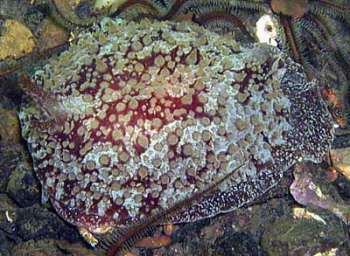
Dear Dr. Rudman,
The attached photo of Pleurobranchus membranaceus was taken on 16 Nov 03 at South Gortein reef, Loch Fyne on the west coast of Scotland. Sea temperature 12 deg C.
This animal was one of several found at 20 metres in an agregation of 20-30, in sizes range from approx 28 to 50 mm in length. Other larger agregations of around 50-75 animals were found in adajacent areas about 50 metres apart at 8 metres where previously they had been observed mating in previous mass sighting in 2002 but not seen at this site earlier this year. Many of the animals in the shallower groups were feeding on large solitary ascidians with a long white tube everted into the body of the ascidian.
Kind regards,
Jim A
jander4454@blueyonder.co.uk
Anderson, J., 2003 (Nov 19) Pleurobranchus membranaceus - feeding. [Message in] Sea Slug Forum. Australian Museum, Sydney. Available from http://www.seaslugforum.net/find/11441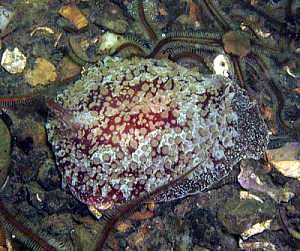
Thanks Jim,
Nice to get another record of this species feeding. We are a bit short of information on pleurobranch feeding so all observations like this are welcome. I have included a copy of your uncropped photo alongside as I am fascinated by the density of brittle stars. I know they are a classic feature of some northern European sea bottoms. Do the pleurobranchs just ignore them? or do they halt and retract every time they encounter a brittle star arm?
Cheers
Bill Rudman
Pleurobranchus membranaceus and eggs
May 23, 2002
From: Jim Anderson
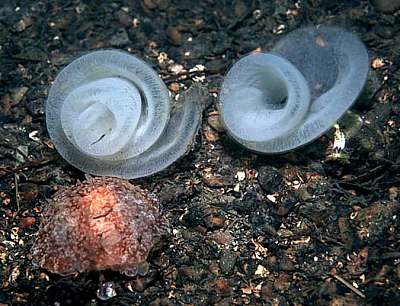
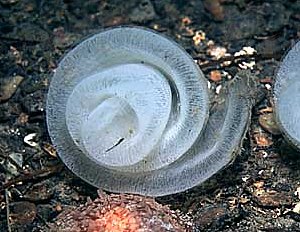
Dear Dr. Rudman,
I promised you an image of spawn a year ago, well here at last it is. The animal in the photo was relocated from a couple of metres away to give scale.
Data: 12 May, 2002. South Gortein, Loch Fyne on the west coast of Scotland. One of many 60mm long animals and spawn seen from 7 to 15 metres in 10 degC. The biggest concentration was on the 7 M level at the point where the muddy sand and cobble slope starts. Many spirals of eggs and groups of up to six animals were found in heaps and others mating, egg-laying, eating white ascidians and the odd dead animal among the debris.
This image and others have been added to my Scottish Nudibranchs website.
Kind regards,
Jim A
jander4454@aol.com
Anderson, J., 2002 (May 23) Pleurobranchus membranaceus and eggs. [Message in] Sea Slug Forum. Australian Museum, Sydney. Available from http://www.seaslugforum.net/find/7001Dear Jim,
Thanks very much. I am surprised at how large the egg mass is relative to the size of the animal. I found a reference by Tom Thompson (1976) to a study of this species in the Mediterranean by Tchang-Si (1931) who eported that egg ribbons can be very large [1,795,500 eggs per ribbon] and that the egg ribbon takes up water after it is laid so that a 140g adult may produce an egg mass weighing 150g. The eggs are small, and develop into free-swimming planktotrophic larvae. Talking of swimming - I was most impressed with the photo on your website showing an animal swimming just as Thompson & Slinn(1959) described it.
Best wishes,
Bill Rudman
Re: 'Highland Dancer'
April 22, 2001
From: Jim Anderson
Dear Dr Rudman,
Thanks for the information on the swimming activity. I will look out for these animals this spring and try and photograph some spawn spirals for your site.
Regards,
Jim A
jander4454@aol.com
Anderson, J., 2001 (Apr 22) Re: 'Highland Dancer'. [Message in] Sea Slug Forum. Australian Museum, Sydney. Available from http://www.seaslugforum.net/find/4213Pleurobranchus membranaceus
April 21, 2001
From: Jim Anderson


Dear Dr Rudman,
I have attached the accompanying images of Pleurobranchus membranaceus to add to your list.
Based on my observations, these animals appear in our Scottish west coast sea lochs from April/May onwards when the sea temperature is around 9-10 deg C, leaving their distinctive large spiral ribbons of spawn on all sorts of substrates, mud, stones, gravel etc. We find them regularly from depths just below the LW line down to 20 m. They are approx 60 - 75 mm in dia and can be found until late autumn (that's November here). We have christened them as 'Highland Dancers' due to their swimming ability (upside down and sinuous mantle flapping) as the Spanish Dancers probably better known to you folks in the warmer seas. I have only once observed a specimen swimming without the prior intervention of a diver, it was 'headed' into shallower water at 12M in a loch that drops to 70M, so I am sure this is a natural behaviour and method of locomotion and not one induced by dive leaders to 'amuse' their charges.
These images and a general update of the Scottish Nudibranch website http://www.a4454.freeserve.co.uk/scotnud1.html will be online from 16 April.
Kind regards
Jim Anderson
jander4454@aol.com
Anderson, J., 2001 (Apr 21) Pleurobranchus membranaceus. [Message in] Sea Slug Forum. Australian Museum, Sydney. Available from http://www.seaslugforum.net/find/4189Thanks Jim,
I won't go too deeply into your image of a Highland Dancer 'upside down' with their kilt flapping. I remember being fascinated by Thompson & Slinn's account (1959) of swimming in Pleurobranchus membranaceus. They report a mass invasion of swimming animals at Port Erin, Isle of Man, and could find 3 or 4 earlier references to 'invasions of swimming animals' at Torbay and Plymouth in England.
A number of opisthobranchs swim by flapping wing-like structures (see Sagaminopteron ornatum and Aplysia extraordinaria) but P. membranaceus differs in the asynchronous nature of the flapping. It swims upside down. The mantle hangs down and is not used in swimming, while the sides of the foot extend out as large thin flaps, much larger than when the animal is crawling. During swimming the foot on one side flaps by sending a wave from the front to rear and then while it is recovering for the next propulsive stroke, the other side of the foot undergoes its propulsive stroke. This makes swimming a very ungainly unstable movement, the animals rolling from side to side as it swims along. Animals do not appear to swim in any direction. In Jim's lower photo we can see that the side of the foot at the back of the photo is extended for swimming, while the side of the foot closest to us is not.
Reference:
• Thompson, T.E. & Slinn, D.J. (1959) On the biology of the opisthobranch Pleurobranchus membranaceus. Journal of the Marine Biological Association, United Kingdom, 38: 507-524.
Best wishes,
Bill Rudman.
